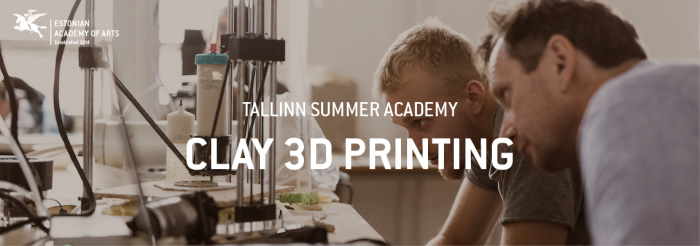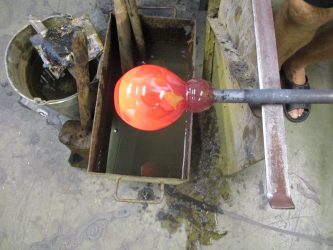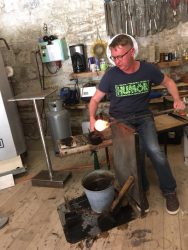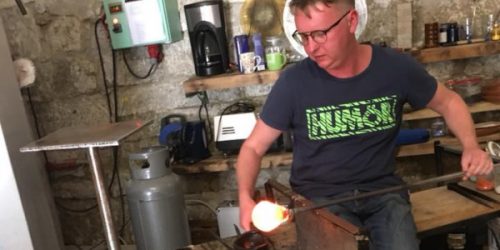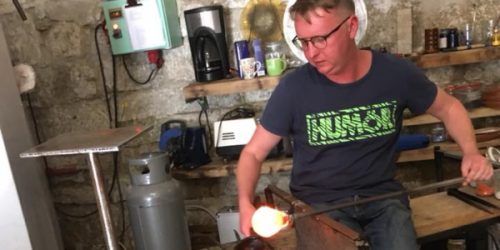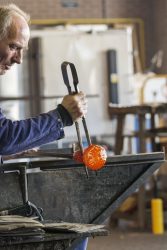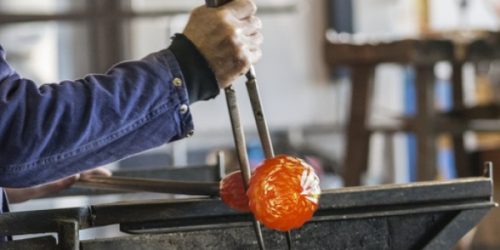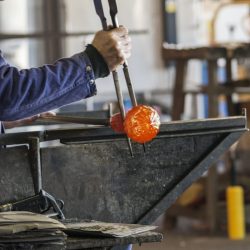Avatud Akadeemia kursused
08.05.2018 — 11.05.2018
Moe- ja trendide prognoosid
NB! Valides registreerimisvormis kõik kolm moekursust – Luxury Brand Management, Luxury and Fashion Study Trip to London ning Moe- ja trendide prognoosid, on hinnasoodustus 25%.
Moe- ja trendide prognoosid: trendi anatoomia ja trendide ajajoon moedisaini protsessi ja moetarbimise mõjutajana.
Moetrendide ennustamine on loovtöö, millel on reaalne kommertslik resultaat.
Moeennustused aitavad prognoosida, milliseid tooteid brändid ja jaemüüjad peaksid kavandama ja müüma, minimiseerides riske ja vältides ressursside raiskamist ja kulutusi. Ennustused aitavad ka sihttarbijast üks või kaks sammu eespool olla neid mõistes nii, et oleks võimalik pakkuda neile tooteid, mida nad soovivad.
Käsitletavad teemad:
- Trendide ennustamine kui kunst, teadus, matemaatika ja loogika. Intuitsiooni, kogemuste ja andmete kombineerimine. Moesuundade mäletamise mälu. Moesuundade prognoosimine, trendide ajajoon ja tuleviku stsenaariumid 10 aastat ettepoole.
- Demograafiline analüüs 5 aastat ettepoole ja tarbijakäitumise stsenaariumid. Moetarbija läbi erinevate generatsioonide muutuvas moemaailmas kui tuleviku mõjutaja.
- Visioonid 2 aastat ettepoole: värvid, tekstiilid, disainiarendused tootegruppide kaupa, hooaja tähtsamad ”võtmetooted”. Hetketrendide tajumine. Trendid peegeldavad seda, kuidas me valime oma elu elada.
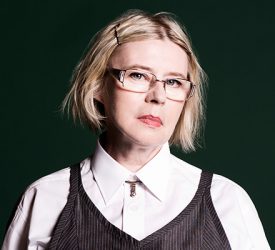
Juhendaja Vilve Unt on olnud kauaaegne Eesti Kunstiakadeemia moedisaini osakonna professor ja avatud akadeemia moestilistika õppekava juht, kes moetudengite koolitamise kõrvalt on viimastel aastatel aktiivselt esinenud oma loominguga moenäitustel ja moekollektsioonidega Tallinn Fashion Week’i üritustel. Tema loomingut on tunnustatud Hõbenõela auhinnaga.
Vilve Unt peab oma loomingu juures oluliseks pikaaegset elukogemust moevaldkonnas ning sellest tulenevat kindlust muutuvate moevoolude keskel iseendaks jääda. Selliselt positsioonilt sündinud kollektsioonid on autori arvates loodud üheks hetkeks moelavale, kuid kunstina eksponeerimiseks ka näitusesaalis.
“PROMENADE” on Vilve Undi uus kaubamärk, mis edastab ajas kestma jäänud väärtusi, kudumikollektsioonid on mõeldud neile, kes hindavad ajatu ja unikaalse disainiga kvaliteetseid tooteid, mis on kauakestvad ja hooajaülesed.
Aeg: 8., 9., 11. mail 2018 kell 17.30–20.30
Koht: ruum 241, Estonia pst 7, Tallinn
Maht: 12 akadeemilist tundi kontaktõpet
Hind: 150 eurot
Registreeru SIIT
NB! Osaledes kõigil kolmel moekursusel: Moe- ja trendide prognoosid, Luxury Brand Management ja Luxury and Fashion Study Trip to London on hind 525 eurot.
Õppekavarühm: moe-, sise- ja tööstusdisain
Info: koolitus@artun.ee, 626 7327
Moe- ja trendide prognoosid
Teisipäev 08 mai, 2018 — Reede 11 mai, 2018
NB! Valides registreerimisvormis kõik kolm moekursust – Luxury Brand Management, Luxury and Fashion Study Trip to London ning Moe- ja trendide prognoosid, on hinnasoodustus 25%.
Moe- ja trendide prognoosid: trendi anatoomia ja trendide ajajoon moedisaini protsessi ja moetarbimise mõjutajana.
Moetrendide ennustamine on loovtöö, millel on reaalne kommertslik resultaat.
Moeennustused aitavad prognoosida, milliseid tooteid brändid ja jaemüüjad peaksid kavandama ja müüma, minimiseerides riske ja vältides ressursside raiskamist ja kulutusi. Ennustused aitavad ka sihttarbijast üks või kaks sammu eespool olla neid mõistes nii, et oleks võimalik pakkuda neile tooteid, mida nad soovivad.
Käsitletavad teemad:
- Trendide ennustamine kui kunst, teadus, matemaatika ja loogika. Intuitsiooni, kogemuste ja andmete kombineerimine. Moesuundade mäletamise mälu. Moesuundade prognoosimine, trendide ajajoon ja tuleviku stsenaariumid 10 aastat ettepoole.
- Demograafiline analüüs 5 aastat ettepoole ja tarbijakäitumise stsenaariumid. Moetarbija läbi erinevate generatsioonide muutuvas moemaailmas kui tuleviku mõjutaja.
- Visioonid 2 aastat ettepoole: värvid, tekstiilid, disainiarendused tootegruppide kaupa, hooaja tähtsamad ”võtmetooted”. Hetketrendide tajumine. Trendid peegeldavad seda, kuidas me valime oma elu elada.

Juhendaja Vilve Unt on olnud kauaaegne Eesti Kunstiakadeemia moedisaini osakonna professor ja avatud akadeemia moestilistika õppekava juht, kes moetudengite koolitamise kõrvalt on viimastel aastatel aktiivselt esinenud oma loominguga moenäitustel ja moekollektsioonidega Tallinn Fashion Week’i üritustel. Tema loomingut on tunnustatud Hõbenõela auhinnaga.
Vilve Unt peab oma loomingu juures oluliseks pikaaegset elukogemust moevaldkonnas ning sellest tulenevat kindlust muutuvate moevoolude keskel iseendaks jääda. Selliselt positsioonilt sündinud kollektsioonid on autori arvates loodud üheks hetkeks moelavale, kuid kunstina eksponeerimiseks ka näitusesaalis.
“PROMENADE” on Vilve Undi uus kaubamärk, mis edastab ajas kestma jäänud väärtusi, kudumikollektsioonid on mõeldud neile, kes hindavad ajatu ja unikaalse disainiga kvaliteetseid tooteid, mis on kauakestvad ja hooajaülesed.
Aeg: 8., 9., 11. mail 2018 kell 17.30–20.30
Koht: ruum 241, Estonia pst 7, Tallinn
Maht: 12 akadeemilist tundi kontaktõpet
Hind: 150 eurot
Registreeru SIIT
NB! Osaledes kõigil kolmel moekursusel: Moe- ja trendide prognoosid, Luxury Brand Management ja Luxury and Fashion Study Trip to London on hind 525 eurot.
Õppekavarühm: moe-, sise- ja tööstusdisain
Info: koolitus@artun.ee, 626 7327
16.05.2018 — 28.05.2018
Joonistamine botaanikaaias. Taimeaiaimelised
Botaanikas on taimeaiaimelisi. Vaata maikuu kohta: http://botaanikaaed.ee/oiekalender/mai.
Läbi aegade on taimed inspireerinud kunstnikke, disainereid, arhitekte, insenere, muusikuid ja kehakunstnikke looma vorme, arhitektoone, objekte, mustreid, koreograafiat ja lõputult imelisi teoseid.
Taimeaed on imedest tulvil. Vaatame neid joonistaja pilguga. Uurime lähemalt ning kujutame taimi mitmel moel, alates botaanilisest illustratsioonist kuni lihtsustatud märgini, natuurilähedasest kujutamisviisist kuni lihtsustatud vormideni. Loome mustreid.
Katsetame erinevaid töövahendeid, nagu grafiit ja värvipliiatsid, viltpliiatsid, markerid ja värvid. Kasutame erinevaid töövõtteid. Ülesandest ja ilmast lähtuvalt töötame nii avamaal kui ka kasvuhoones.
Vajalikud materjalid: paberid (formaat kuni A2), teip või klambrid paberi kinnitamiseks, markerid, värvi- ja viltpliiatsid, pastellid, pintslid, tušš või värvid. Osaleja võtab materjalid ise kaasa. Kaasaskantav joonistamisalus on kohapeal olemas.
Koolituse läbinu:
- on saanud ülevaate töövahenditest
- on katsetanud erinevaid töövõtteid
- orienteerub erinevates kujutamisviisides
Kursus lõpeb arvestusega, mille sisuks on kohapeal tehtud tööde ja kodutööde esitlus. Arvestuse läbinule väljastatakse Eesti Kunstiakadeemia täienduskoolituse tunnistus.
Kuna töötame õues, panna selga ilmaga sobiv riietus. Kaasa võtta istumisalus ja päikeseprillid. Töövahendite kandmiseks on mugav väike seljakott, et oleks võimalik kiiresti asukohta vahetada.
Juhendaja Ülle Marks on lõpetanud Eesti Riikliku Kunstiinstituudi (ERKI) magistritaseme kunstniku-graafikuna. Ta töötab Eesti Kunstiakadeemia disainiteaduskonna joonistusstuudio juhataja ja joonistamisõpetajana.
Aeg: 16., 17., 21., 23., 28. mail 2018 kl 13–16
Koht: Tallinna Botaanikaaed, Kloostrimetsa tee 52
Maht: 20 akadeemilist tundi kontaktõpet ja 32 akadeemilist tundi iseseisvat tööd (2 EAP)
Hind: 180 eurot (sisaldab sissepääsu piletit)
Registreerumine vormi kaudu SIIT
Õppekavarühm: kujutav kunst ja kunstiteadus
Info ja registreerimine: koolitus@artun.ee, 626 7327
Joonistamine botaanikaaias. Taimeaiaimelised
Kolmapäev 16 mai, 2018 — Esmaspäev 28 mai, 2018
Botaanikas on taimeaiaimelisi. Vaata maikuu kohta: http://botaanikaaed.ee/oiekalender/mai.
Läbi aegade on taimed inspireerinud kunstnikke, disainereid, arhitekte, insenere, muusikuid ja kehakunstnikke looma vorme, arhitektoone, objekte, mustreid, koreograafiat ja lõputult imelisi teoseid.
Taimeaed on imedest tulvil. Vaatame neid joonistaja pilguga. Uurime lähemalt ning kujutame taimi mitmel moel, alates botaanilisest illustratsioonist kuni lihtsustatud märgini, natuurilähedasest kujutamisviisist kuni lihtsustatud vormideni. Loome mustreid.
Katsetame erinevaid töövahendeid, nagu grafiit ja värvipliiatsid, viltpliiatsid, markerid ja värvid. Kasutame erinevaid töövõtteid. Ülesandest ja ilmast lähtuvalt töötame nii avamaal kui ka kasvuhoones.
Vajalikud materjalid: paberid (formaat kuni A2), teip või klambrid paberi kinnitamiseks, markerid, värvi- ja viltpliiatsid, pastellid, pintslid, tušš või värvid. Osaleja võtab materjalid ise kaasa. Kaasaskantav joonistamisalus on kohapeal olemas.
Koolituse läbinu:
- on saanud ülevaate töövahenditest
- on katsetanud erinevaid töövõtteid
- orienteerub erinevates kujutamisviisides
Kursus lõpeb arvestusega, mille sisuks on kohapeal tehtud tööde ja kodutööde esitlus. Arvestuse läbinule väljastatakse Eesti Kunstiakadeemia täienduskoolituse tunnistus.
Kuna töötame õues, panna selga ilmaga sobiv riietus. Kaasa võtta istumisalus ja päikeseprillid. Töövahendite kandmiseks on mugav väike seljakott, et oleks võimalik kiiresti asukohta vahetada.
Juhendaja Ülle Marks on lõpetanud Eesti Riikliku Kunstiinstituudi (ERKI) magistritaseme kunstniku-graafikuna. Ta töötab Eesti Kunstiakadeemia disainiteaduskonna joonistusstuudio juhataja ja joonistamisõpetajana.
Aeg: 16., 17., 21., 23., 28. mail 2018 kl 13–16
Koht: Tallinna Botaanikaaed, Kloostrimetsa tee 52
Maht: 20 akadeemilist tundi kontaktõpet ja 32 akadeemilist tundi iseseisvat tööd (2 EAP)
Hind: 180 eurot (sisaldab sissepääsu piletit)
Registreerumine vormi kaudu SIIT
Õppekavarühm: kujutav kunst ja kunstiteadus
Info ja registreerimine: koolitus@artun.ee, 626 7327
05.05.2018
Kunstilaupäevak. Clean and Draw ehk joonistame pea selgeks
Clean and Draw (eesti keelne info allpool)
This course is for anyone who wants to perform a spring cleaning in their head. We’ll draw sketches that help see our surroundings with a clearer eye and pull ourselves out from the avalanche of everyday responsibilities. We’ll use drawing as a way to get the cobwebs out.
We will look at how drawing practice can help create the necessary distance from the problems confronting us, allowing us to find clarity and new energy within ourselves.
The course will involve use of markers to create sketches in a short space of time, followed by individual and group analysis of the drawings.
No prior drawing experience is required.
Note: the course will be held in English.
Materials needed: participants will bring their own sheets of paper and markers.
Instructor: Allan Kukk, graduate of the Estonian Academy of Arts, master’s degree in graphic art. By profession, he is a graphic artist and graphic designer. Allan is one of the most sought-after continuing education instructors at EKA.
Date and time: 5 May 2018 11:00–16:15 (lunch break from 13:15–14:00)
Place: room 342, Estonia pst. 7, Tallinn
Course duration: 6 academic hours
Price: 65 euros
Registration form HERE
Curriculum group: fine arts and art history
Information and registration: koolitus@artun.ee, 626 7327
Continuing education courses at the Estonian Academy of Arts are oriented toward longer courses and development of skills. This year, we have created a new opportunity for those who aren’t able to participate in longer course formats but still want to broaden their understanding of developments in art, architecture and design, acquire knowledge and skills and benefit from the guidance of the Academy’s instructors.
The courses in question will be held on the third Saturday of each month.
Joonistame pea selgeks
Kursus sobib igaühele, kes soovib korraldada oma peas koristuspäeva. Joonistame visandeid, mis aitavad näha ümbritsevat värskema pilguga ja eemalduda hetkeks igapäevakohustuste laviini alt. Joonistamine on kui puhastusvahend.
Vaatleme, kuidas joonistamisharjumus aitab luua vajalikku distantsi ees olevate probleemidega, et leida endas selgust ja uut energiat.
Kursusel teeme markeriga lühiajalisi visandeid ning analüüsime joonistusi nii individuaalselt kui ka rühmas.
Harjutused ei eelda eelnevat joonistamiskogemust.
NB! Kursus toimub inglise keeles.
Vajalikud materjalid: paberid, markerid võtab osaleja ise kaasa.
Juhendaja: Allan Kukk on lõpetanud Eesti Kunstiakadeemia graafikaeriala magistriõppe. Ta on graafik ja graafiline disainer, Allan on EKA täienduskoolituse hinnatud juhendaja.
Aeg: 5. mail 2018 kell 11–16.15 (kl 13.15–14 lõunapaus)
Koht: Ruum 342, Estonia pst 7, Tallinn
Maht: 6 akadeemilist tundi
Hind: 65 eurot
Registreerumine vormi kaudu SIIT
Õppekavarühm: kujutav kunst ja kunstiteadus
Info ja registreerimine: koolitus@artun.ee, 626 7327
Eesti kunstiakadeemia täienduskoolitused on olnud suunatud pikematele kursustele ning oskuste kujunemisele. Sel aastal oleme loonud uue võimaluse neile, kellel pole võimalik osaleda pikematel kursustel, aga kes siiski soovivad mõista kunsti-arhitektuuri ja disaini valdkonna arenguid, saada teadmisi ja oskusi ning saada osa kunstiakadeemia juhendajate toest.
Kunstilaupäevakud saavad toimuma üldjuhul kuu kolmandal laupäeval.
Kunstilaupäevak. Clean and Draw ehk joonistame pea selgeks
Laupäev 05 mai, 2018
Clean and Draw (eesti keelne info allpool)
This course is for anyone who wants to perform a spring cleaning in their head. We’ll draw sketches that help see our surroundings with a clearer eye and pull ourselves out from the avalanche of everyday responsibilities. We’ll use drawing as a way to get the cobwebs out.
We will look at how drawing practice can help create the necessary distance from the problems confronting us, allowing us to find clarity and new energy within ourselves.
The course will involve use of markers to create sketches in a short space of time, followed by individual and group analysis of the drawings.
No prior drawing experience is required.
Note: the course will be held in English.
Materials needed: participants will bring their own sheets of paper and markers.
Instructor: Allan Kukk, graduate of the Estonian Academy of Arts, master’s degree in graphic art. By profession, he is a graphic artist and graphic designer. Allan is one of the most sought-after continuing education instructors at EKA.
Date and time: 5 May 2018 11:00–16:15 (lunch break from 13:15–14:00)
Place: room 342, Estonia pst. 7, Tallinn
Course duration: 6 academic hours
Price: 65 euros
Registration form HERE
Curriculum group: fine arts and art history
Information and registration: koolitus@artun.ee, 626 7327
Continuing education courses at the Estonian Academy of Arts are oriented toward longer courses and development of skills. This year, we have created a new opportunity for those who aren’t able to participate in longer course formats but still want to broaden their understanding of developments in art, architecture and design, acquire knowledge and skills and benefit from the guidance of the Academy’s instructors.
The courses in question will be held on the third Saturday of each month.
Joonistame pea selgeks
Kursus sobib igaühele, kes soovib korraldada oma peas koristuspäeva. Joonistame visandeid, mis aitavad näha ümbritsevat värskema pilguga ja eemalduda hetkeks igapäevakohustuste laviini alt. Joonistamine on kui puhastusvahend.
Vaatleme, kuidas joonistamisharjumus aitab luua vajalikku distantsi ees olevate probleemidega, et leida endas selgust ja uut energiat.
Kursusel teeme markeriga lühiajalisi visandeid ning analüüsime joonistusi nii individuaalselt kui ka rühmas.
Harjutused ei eelda eelnevat joonistamiskogemust.
NB! Kursus toimub inglise keeles.
Vajalikud materjalid: paberid, markerid võtab osaleja ise kaasa.
Juhendaja: Allan Kukk on lõpetanud Eesti Kunstiakadeemia graafikaeriala magistriõppe. Ta on graafik ja graafiline disainer, Allan on EKA täienduskoolituse hinnatud juhendaja.
Aeg: 5. mail 2018 kell 11–16.15 (kl 13.15–14 lõunapaus)
Koht: Ruum 342, Estonia pst 7, Tallinn
Maht: 6 akadeemilist tundi
Hind: 65 eurot
Registreerumine vormi kaudu SIIT
Õppekavarühm: kujutav kunst ja kunstiteadus
Info ja registreerimine: koolitus@artun.ee, 626 7327
Eesti kunstiakadeemia täienduskoolitused on olnud suunatud pikematele kursustele ning oskuste kujunemisele. Sel aastal oleme loonud uue võimaluse neile, kellel pole võimalik osaleda pikematel kursustel, aga kes siiski soovivad mõista kunsti-arhitektuuri ja disaini valdkonna arenguid, saada teadmisi ja oskusi ning saada osa kunstiakadeemia juhendajate toest.
Kunstilaupäevakud saavad toimuma üldjuhul kuu kolmandal laupäeval.
06.08.2018 — 10.08.2018
Summer Academy: Interaction Design Tomorrow
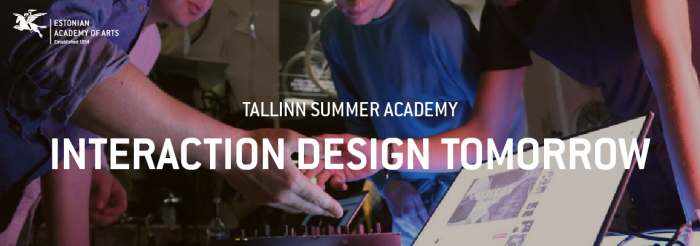
Dates: 6–10 August 2018
Volume: 40 hours, 3 ECTS
Location: Estonian Centre of Architecture, Põhja pst 27a, Tallinn, Estonia
Number of participants: max 20
Cost: FREE (Please note that this course is meant for higher education students only)
Registration deadline: 6th of May
Aimed at design students; no programming skills necessary.
In addition to the general required materials, candidates are expected to submit a letter of motivation explaining why they are applying and outlining their experience with Interaction Design so far (max A4). Students are expected to bring their own sketchbooks, markers and laptops.
Over the course of a week you will learn about the foundations, history and possible futures of interaction design within a studio environment. This 5-day hands-on workshop provides a solid foundational knowledge of user experience (UX) design for new practitioners, as well as an in-depth exploration of interaction design for experienced designers. The course gives participants space and guidance to delve deeply into theoretical and practical aspects of interaction design by investigating contemporary issues and proposing design solutions.
Through a series of lectures, films, historic case studies and studio practice, participants will explore the nature and aesthetics of interaction design in the digital and physical space, in individual and group studio practice from ideation and the iterative design process to presentations and critique.
Learning outcomes:
- Learn about design foundations, theory, history and practice
- Understand how to look at problems from social, technological, economic and cultural perspectives
- Practice design research and synthesis
- Learn how to be creative in the digital realm
- Improve your ability to present your design concepts
- Practice working individually and in small teams
More information and link to registration: https://www.artun.ee/summeracademy/interaction-design-tomorrow/
Summer Academy: Interaction Design Tomorrow
Esmaspäev 06 august, 2018 — Reede 10 august, 2018

Dates: 6–10 August 2018
Volume: 40 hours, 3 ECTS
Location: Estonian Centre of Architecture, Põhja pst 27a, Tallinn, Estonia
Number of participants: max 20
Cost: FREE (Please note that this course is meant for higher education students only)
Registration deadline: 6th of May
Aimed at design students; no programming skills necessary.
In addition to the general required materials, candidates are expected to submit a letter of motivation explaining why they are applying and outlining their experience with Interaction Design so far (max A4). Students are expected to bring their own sketchbooks, markers and laptops.
Over the course of a week you will learn about the foundations, history and possible futures of interaction design within a studio environment. This 5-day hands-on workshop provides a solid foundational knowledge of user experience (UX) design for new practitioners, as well as an in-depth exploration of interaction design for experienced designers. The course gives participants space and guidance to delve deeply into theoretical and practical aspects of interaction design by investigating contemporary issues and proposing design solutions.
Through a series of lectures, films, historic case studies and studio practice, participants will explore the nature and aesthetics of interaction design in the digital and physical space, in individual and group studio practice from ideation and the iterative design process to presentations and critique.
Learning outcomes:
- Learn about design foundations, theory, history and practice
- Understand how to look at problems from social, technological, economic and cultural perspectives
- Practice design research and synthesis
- Learn how to be creative in the digital realm
- Improve your ability to present your design concepts
- Practice working individually and in small teams
More information and link to registration: https://www.artun.ee/summeracademy/interaction-design-tomorrow/
06.08.2018 — 11.08.2018
Summer Academy: The Anatomy of Couture
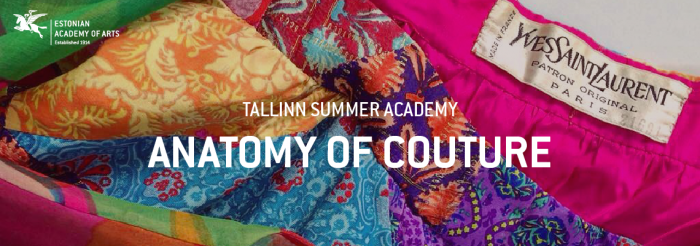 Dates: 6-11 August 2018
Dates: 6-11 August 2018
Volume: 6 days, 3 ECTS
Location: Tallinn City Museum, Vene Str 17
Number of participants: max 22
Cost: FREE (Please note that this course is meant for higher education students only.)
Registration deadline: 6th of May
Students applying for a slot in this workshop are asked to submit a CV and cover letter describing why they wish to participate and whether they have any old article of clothing to bring with them to Estonia. The cover letter should also reveal why they are interested in restoring textiles and haute couture.
Aim of the course:
- bring a disappearing specialized manual skill to Estonia and teach it to Estonian and international students
- restore articles of clothing in the collection of some Estonian museum and thereby contribute to the preservation of an exhibit item with historical value.
Course content:
The course provides practical and theoretical knowledge of how to restore old clothing – selection of fabrics, stitches and seams, treatment of the material, how different materials age, how to care for and restore different fabrics. In the course of the workshop, students will learn about the internal structure of haute couture clothing, allowing them to later create period-specific silhouettes or re-interpretations of them – pattern solutions for textiles, materials. The course will provide knowledge and skills that can be used to get closer to the secrets of high fashion. All of the participants in the course will be able to restore a part of dresses brought in by the lecturer.
The course teaches handicraft skills that have become a rarity, something highly sought-after among professionals. ˇFewer and fewer people practise these skills in a world dominated by modern fashions. Today clothing made 40, 50, even 100 years ago are held in high regard, as they involved the use of original patterns, hand stitching, high-quality tailoring. To this point, the creation of such clothing have remained shrouded in arcane mystery – they seem easy to imitate at first glance but it is impossible to achieve the right effect without knowing what is going on “under the dress.”
The course is mainly meant for fashion design, theatre design, restoration and design students.
More information and link to registration: https://www.artun.ee/summeracademy/the-anatomy-of-couture/
Summer Academy: The Anatomy of Couture
Esmaspäev 06 august, 2018 — Laupäev 11 august, 2018
 Dates: 6-11 August 2018
Dates: 6-11 August 2018
Volume: 6 days, 3 ECTS
Location: Tallinn City Museum, Vene Str 17
Number of participants: max 22
Cost: FREE (Please note that this course is meant for higher education students only.)
Registration deadline: 6th of May
Students applying for a slot in this workshop are asked to submit a CV and cover letter describing why they wish to participate and whether they have any old article of clothing to bring with them to Estonia. The cover letter should also reveal why they are interested in restoring textiles and haute couture.
Aim of the course:
- bring a disappearing specialized manual skill to Estonia and teach it to Estonian and international students
- restore articles of clothing in the collection of some Estonian museum and thereby contribute to the preservation of an exhibit item with historical value.
Course content:
The course provides practical and theoretical knowledge of how to restore old clothing – selection of fabrics, stitches and seams, treatment of the material, how different materials age, how to care for and restore different fabrics. In the course of the workshop, students will learn about the internal structure of haute couture clothing, allowing them to later create period-specific silhouettes or re-interpretations of them – pattern solutions for textiles, materials. The course will provide knowledge and skills that can be used to get closer to the secrets of high fashion. All of the participants in the course will be able to restore a part of dresses brought in by the lecturer.
The course teaches handicraft skills that have become a rarity, something highly sought-after among professionals. ˇFewer and fewer people practise these skills in a world dominated by modern fashions. Today clothing made 40, 50, even 100 years ago are held in high regard, as they involved the use of original patterns, hand stitching, high-quality tailoring. To this point, the creation of such clothing have remained shrouded in arcane mystery – they seem easy to imitate at first glance but it is impossible to achieve the right effect without knowing what is going on “under the dress.”
The course is mainly meant for fashion design, theatre design, restoration and design students.
More information and link to registration: https://www.artun.ee/summeracademy/the-anatomy-of-couture/
20.08.2018 — 25.08.2018
Summer Academy: Wood and Design
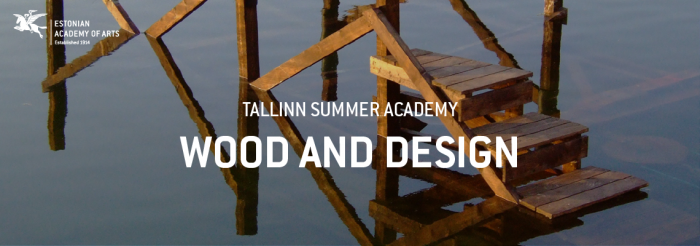
Dates: 20–25 August 2018
Volume: 6 days, 3 ECTS
Location: Loodi Manor, Viljandi, Estonia
Number of participants: max 22
Cost: FREE (Please note that this course is meant for higher education students only)
Registration deadline: 6th of May
In addition to the general admissions requirements, candidates are expected to submit a letter of intent describing their interest in attending the workshop, and a PDF portfolio including documentation of at least one project relevant to the use and/or attributes of wood.
This 6-day workshop Wood and Design in the lush woodlands of Viljandi, Estonia, focuses on the design aesthetics, ecology, and sustainability of wood. Exploring themateri al properties of wood through its use in design, the workshop invites participants to build a set of functional wooden objects for outdoor living with the simplest of means. Participants will utilise wood, as a naturally-occurring renewable material, in two forms: solid slab and left-over scraps from local lumber mills. The workshop is therefore not only community-inspired, with materials sourced or found locally, but also meets the ever-growing need to reclaime and recycle waste wood.
Level:
2nd and 3rd year BA students and MA students in Interior Architecture, Furniture Design, or the equivalent.
More information and link to registration: https://www.artun.ee/summeracademy/wood-and-design/
Summer Academy: Wood and Design
Esmaspäev 20 august, 2018 — Laupäev 25 august, 2018

Dates: 20–25 August 2018
Volume: 6 days, 3 ECTS
Location: Loodi Manor, Viljandi, Estonia
Number of participants: max 22
Cost: FREE (Please note that this course is meant for higher education students only)
Registration deadline: 6th of May
In addition to the general admissions requirements, candidates are expected to submit a letter of intent describing their interest in attending the workshop, and a PDF portfolio including documentation of at least one project relevant to the use and/or attributes of wood.
This 6-day workshop Wood and Design in the lush woodlands of Viljandi, Estonia, focuses on the design aesthetics, ecology, and sustainability of wood. Exploring themateri al properties of wood through its use in design, the workshop invites participants to build a set of functional wooden objects for outdoor living with the simplest of means. Participants will utilise wood, as a naturally-occurring renewable material, in two forms: solid slab and left-over scraps from local lumber mills. The workshop is therefore not only community-inspired, with materials sourced or found locally, but also meets the ever-growing need to reclaime and recycle waste wood.
Level:
2nd and 3rd year BA students and MA students in Interior Architecture, Furniture Design, or the equivalent.
More information and link to registration: https://www.artun.ee/summeracademy/wood-and-design/
20.08.2018 — 24.08.2018
Summer Academy: Numbers and Cognition in the Urban Environment
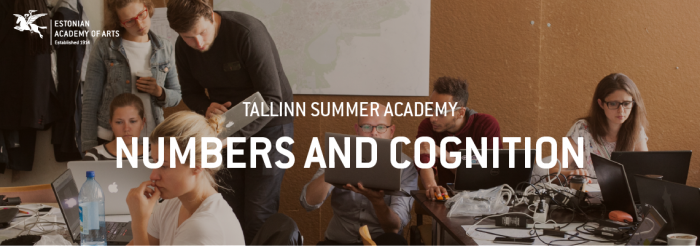
Dates: 20–24 August 2018
Volume: 40 hours, 3 ECTS
Location: Department of Architecture at the Estonian Academy of Arts, Pikk tn 20, 3rd floor, Tallinn
Number of participants: max 25
Cost: FREE (Please note that this course is meant for higher education students only)
Registration deadline: 6th of May
In case of high volume of applications, prospective participants are asked to write an essay one A4-format page in length (approximately 250 words).
Content of the course
This workshop is structured on architecture, numbers and cognition with the focus mainly on public space. Two broader topics pervade the workshop. One of them is more physical, involving translating the world into parameters, and the other is mapping social activities. The broad goal is to find connections between the two sets of topics. The environment around us consists of a number of physically countable and measurable parameters, which we can use to describe it (width of a carriageway, location of a cafe). Which parameters are the best for describing or designing the world? As another important topic, we will map the movements or activities of human masses, using photo and image analysis and Wi-Fi positioning to this end. When, why and where are people moving and how long do they stop – this is an important set of topics, because the quality of space is largely dependent on the presence of people. The participants in the summer academy course will be challenged to find relationships between the physical world and human activity. It will be important to find a means and method for measuring and documenting the environment. Cognition referred to in the course name refers to experience that can be used in future to make decisions to design and re-design space. Ideally, we envision the participants who complete the academy to be capable of imagining and perceiving the implications of 1,000 people or 100 cars passing a point.
Picking key parameters (properties) from this environment has long received attention from urbanism scholars: William H. Whyte, who attempted to trace patterns of use of public space, or Kevin Lynch, who tried to find the mental model people use to understand a city.
The late 20th century brought a rise in computing power, which has resulted in change in the accuracy and use of many calculations. In the past, it was not conceivable to calculate trajectories from one building to another manually, but it is now possible. Alongside this trend, a completely new field has arisen: various kinds of simulations. Simulations make it possible to model traffic, pedestrians or both at the same time. Gathering data has become more intensive with a focus moving from gathering qualitative data to collecting quantitative data. A large part of the summer school involves field observations, which helps instil intuition in participants as to what a given indicator means. This will also give them a clearer understanding of the computational processes and outcomes and they will be able to rationally assess the outcomes of some simulation or facts presented to them.
Participants will become well-versed in methods and means for quantitatively and qualitatively documenting the street-level space, which can in turn later be used for analysis of other places. The participant will also receive an overview of and access to software used in the framework of the workshop. At the end of the summer school, all of the data that was gathered will be made public to allow third parties to use them in their projects – for example, to plan more fluid, safer traffic conditions.
More information and link to registration: https://www.artun.ee/summeracademy/numbers-and-cognition/
Summer Academy: Numbers and Cognition in the Urban Environment
Esmaspäev 20 august, 2018 — Reede 24 august, 2018

Dates: 20–24 August 2018
Volume: 40 hours, 3 ECTS
Location: Department of Architecture at the Estonian Academy of Arts, Pikk tn 20, 3rd floor, Tallinn
Number of participants: max 25
Cost: FREE (Please note that this course is meant for higher education students only)
Registration deadline: 6th of May
In case of high volume of applications, prospective participants are asked to write an essay one A4-format page in length (approximately 250 words).
Content of the course
This workshop is structured on architecture, numbers and cognition with the focus mainly on public space. Two broader topics pervade the workshop. One of them is more physical, involving translating the world into parameters, and the other is mapping social activities. The broad goal is to find connections between the two sets of topics. The environment around us consists of a number of physically countable and measurable parameters, which we can use to describe it (width of a carriageway, location of a cafe). Which parameters are the best for describing or designing the world? As another important topic, we will map the movements or activities of human masses, using photo and image analysis and Wi-Fi positioning to this end. When, why and where are people moving and how long do they stop – this is an important set of topics, because the quality of space is largely dependent on the presence of people. The participants in the summer academy course will be challenged to find relationships between the physical world and human activity. It will be important to find a means and method for measuring and documenting the environment. Cognition referred to in the course name refers to experience that can be used in future to make decisions to design and re-design space. Ideally, we envision the participants who complete the academy to be capable of imagining and perceiving the implications of 1,000 people or 100 cars passing a point.
Picking key parameters (properties) from this environment has long received attention from urbanism scholars: William H. Whyte, who attempted to trace patterns of use of public space, or Kevin Lynch, who tried to find the mental model people use to understand a city.
The late 20th century brought a rise in computing power, which has resulted in change in the accuracy and use of many calculations. In the past, it was not conceivable to calculate trajectories from one building to another manually, but it is now possible. Alongside this trend, a completely new field has arisen: various kinds of simulations. Simulations make it possible to model traffic, pedestrians or both at the same time. Gathering data has become more intensive with a focus moving from gathering qualitative data to collecting quantitative data. A large part of the summer school involves field observations, which helps instil intuition in participants as to what a given indicator means. This will also give them a clearer understanding of the computational processes and outcomes and they will be able to rationally assess the outcomes of some simulation or facts presented to them.
Participants will become well-versed in methods and means for quantitatively and qualitatively documenting the street-level space, which can in turn later be used for analysis of other places. The participant will also receive an overview of and access to software used in the framework of the workshop. At the end of the summer school, all of the data that was gathered will be made public to allow third parties to use them in their projects – for example, to plan more fluid, safer traffic conditions.
More information and link to registration: https://www.artun.ee/summeracademy/numbers-and-cognition/
13.08.2018 — 17.08.2018
Summer Academy: Clay 3D Printing
Dates: 13–17 August 2018
Volume: 40 hours, 2 ECTS
Location: Estonian Academy of Arts, Estonia pst 7, room No E-426
Number of participants: max 13
Cost: FREE (Please note that this course is meant for higher education students only.)
Registration deadline: 6th of May
In addition to the general required materials, candidates are expected to submit a letter of motivation explaining why they are applying and what is their experience with 3D printing so far (max A4).
The Department of Ceramics at the Estonian Academy of Arts invites you to participate in an international Clay 3D Printing workshop. Ceramics have properties that allow it to be used in the most disparate fields. We usually don’t consider that ceramics are all around us, not just in kitchenware, but also in bathrooms, swimming pools and public interiors, and that stoves and fireplaces, even houses, are made of fired clay. Top-quality ceramics can be found in medical equipment, audio technology and air and space industry. Clay is sensitive, flexible and versatile material with its’ own technological limits which the participants will learn during the workshop.
3D printing in clay allows us to print three-dimensional objects or models at lower cost and more easily. For ceramists, it represents a new technological possibility, while for others it gives a chance to convert digital sketches into real three-dimensional objects. During this course, participants will learn the technical skills of 3D printing and printing in clay: creating G-code and STL files, plus preparation of the clay and printing. The aim of the course is to use innovative thinking to discover new ways of printing, using clay and the printed ceramics. The end of the workshop will feature a pop-up exhibition of the objects created.
The workshop is aimed at ceramics, architecture and design students, but admission is open to all students who have had experience with 3D printing and know how to create 3D files. Every participant needs to bring their own laptop. All other materials are provided, and students may keep the objects they print.
Homework assignment for selectees:
1) students will be asked to bring one of their 3D-file, print ready
2) students will be asked to come up with a design they would like to execute in the workshop. They will be asked to give a presentation on the design in person. As in a hackathon, they will then set to work on the problem.
More information and link to registration: https://www.artun.ee/summeracademy/clay-3d-printing/
Summer Academy: Clay 3D Printing
Esmaspäev 13 august, 2018 — Reede 17 august, 2018
Dates: 13–17 August 2018
Volume: 40 hours, 2 ECTS
Location: Estonian Academy of Arts, Estonia pst 7, room No E-426
Number of participants: max 13
Cost: FREE (Please note that this course is meant for higher education students only.)
Registration deadline: 6th of May
In addition to the general required materials, candidates are expected to submit a letter of motivation explaining why they are applying and what is their experience with 3D printing so far (max A4).
The Department of Ceramics at the Estonian Academy of Arts invites you to participate in an international Clay 3D Printing workshop. Ceramics have properties that allow it to be used in the most disparate fields. We usually don’t consider that ceramics are all around us, not just in kitchenware, but also in bathrooms, swimming pools and public interiors, and that stoves and fireplaces, even houses, are made of fired clay. Top-quality ceramics can be found in medical equipment, audio technology and air and space industry. Clay is sensitive, flexible and versatile material with its’ own technological limits which the participants will learn during the workshop.
3D printing in clay allows us to print three-dimensional objects or models at lower cost and more easily. For ceramists, it represents a new technological possibility, while for others it gives a chance to convert digital sketches into real three-dimensional objects. During this course, participants will learn the technical skills of 3D printing and printing in clay: creating G-code and STL files, plus preparation of the clay and printing. The aim of the course is to use innovative thinking to discover new ways of printing, using clay and the printed ceramics. The end of the workshop will feature a pop-up exhibition of the objects created.
The workshop is aimed at ceramics, architecture and design students, but admission is open to all students who have had experience with 3D printing and know how to create 3D files. Every participant needs to bring their own laptop. All other materials are provided, and students may keep the objects they print.
Homework assignment for selectees:
1) students will be asked to bring one of their 3D-file, print ready
2) students will be asked to come up with a design they would like to execute in the workshop. They will be asked to give a presentation on the design in person. As in a hackathon, they will then set to work on the problem.
More information and link to registration: https://www.artun.ee/summeracademy/clay-3d-printing/
06.08.2018 — 08.08.2018
Summer Academy: The Contemporary Art Field in Estonia
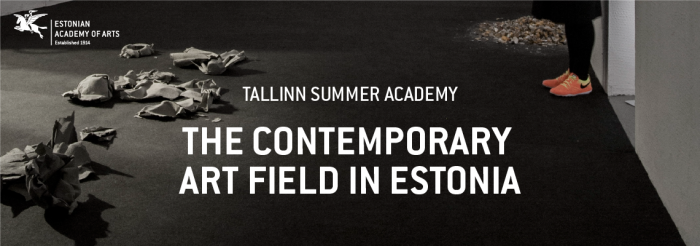
Dates: 6-8 August 2018
Location: ARS Art Factory, Pärnu mnt 154, Tallinn, room no 111
Volume: 24 academic hours, 1 ECTS
Number of participants: max 22
Cost: FREE (Please note that this course is meant for higher education students only.)
Registration deadline: 6th of May
In addition to the general required materials, candidates are expected to submit a letter of motivation explaining why they are applying (max A4).
The Contemporary Art Field in Estonia short course is meant for international art history or curatorship students who are who are studying contemporary Estonian or Baltic art, are interested in the contemporary Estonian art world and in working with Estonian artists, curators or art historians, plan to enrol at the Estonian Academy of Arts and are looking for an overview of how the local art landscape operates. The workshop will be led by Academy of Arts teaching staff member, head of the Centre for General Theory Subjects and freelance art critic Maarin Ektermann.
The short course provides an overview of how contemporary art scene in Estonia functions – the most important organizations, the movers and shakers, the currently important and active artists from different disciplines, and the types of events being held. The causal factors behind the art scene are also explored, starting from the restoration of independence, Estonian art in the context of the regional and broader international art scene, and much more.
Topics to be discussed:
- Trends in contemporary art (social criticism, new painting, installation – architectural approach – public space, photography, graphic design, applied arts, etc.). Examples of artists and their work.
- The functioning of the art scene – who is active (what types of professions are feasible in Estonia), how are they funded (Ministry of Culture, Cultural Endowment of Estonia, creative industries, the law that requires a 1% art budget for public buildings, private capital, the art market, artists and work), general diagnostics – bottlenecks and success stories. The development of the art scene since the 1990s, illustrated by keywords.
- Central institutions and platforms (public and private capital-based). What is characteristic for, e.g. galleries, town galleries in county seats, creative industries centres, etc.? Other examples: artists’ residencies, culture factories, Tallinn Art Hall, Tartu Art Museum, Temnikova and Kasela Gallery, Centre of Contemporary Art Estonia, Estonian Artists’ Association.
- Formats and locations of various events. Concentration of art scene mainly in Tallinn and Tartu – what’s going on elsewhere?
More info and link to registration: https://www.artun.ee/summeracademy/the-contemporary-art-field-in-estonia/
Summer Academy: The Contemporary Art Field in Estonia
Esmaspäev 06 august, 2018 — Kolmapäev 08 august, 2018

Dates: 6-8 August 2018
Location: ARS Art Factory, Pärnu mnt 154, Tallinn, room no 111
Volume: 24 academic hours, 1 ECTS
Number of participants: max 22
Cost: FREE (Please note that this course is meant for higher education students only.)
Registration deadline: 6th of May
In addition to the general required materials, candidates are expected to submit a letter of motivation explaining why they are applying (max A4).
The Contemporary Art Field in Estonia short course is meant for international art history or curatorship students who are who are studying contemporary Estonian or Baltic art, are interested in the contemporary Estonian art world and in working with Estonian artists, curators or art historians, plan to enrol at the Estonian Academy of Arts and are looking for an overview of how the local art landscape operates. The workshop will be led by Academy of Arts teaching staff member, head of the Centre for General Theory Subjects and freelance art critic Maarin Ektermann.
The short course provides an overview of how contemporary art scene in Estonia functions – the most important organizations, the movers and shakers, the currently important and active artists from different disciplines, and the types of events being held. The causal factors behind the art scene are also explored, starting from the restoration of independence, Estonian art in the context of the regional and broader international art scene, and much more.
Topics to be discussed:
- Trends in contemporary art (social criticism, new painting, installation – architectural approach – public space, photography, graphic design, applied arts, etc.). Examples of artists and their work.
- The functioning of the art scene – who is active (what types of professions are feasible in Estonia), how are they funded (Ministry of Culture, Cultural Endowment of Estonia, creative industries, the law that requires a 1% art budget for public buildings, private capital, the art market, artists and work), general diagnostics – bottlenecks and success stories. The development of the art scene since the 1990s, illustrated by keywords.
- Central institutions and platforms (public and private capital-based). What is characteristic for, e.g. galleries, town galleries in county seats, creative industries centres, etc.? Other examples: artists’ residencies, culture factories, Tallinn Art Hall, Tartu Art Museum, Temnikova and Kasela Gallery, Centre of Contemporary Art Estonia, Estonian Artists’ Association.
- Formats and locations of various events. Concentration of art scene mainly in Tallinn and Tartu – what’s going on elsewhere?
More info and link to registration: https://www.artun.ee/summeracademy/the-contemporary-art-field-in-estonia/
30.07.2018 — 31.07.2018
Klaasipuhumise ja klaashelmeste valmistamise töötuba
Töötuba annab ülevaate kahest klaasi kuumtöötlustehnikast — puhumisest ja leekpõletil helmeste valmistamisest. Kursuse käigus saab proovida kuuma klaasi puhumist ja modelleerimist. Leekpõletil valmistame klaashelmeid, nendest võib kursuse käigus valmistada kas iseendale või kingituseks ehteid.
Kava:
30. juuli
Kuumtöötlustehnikate tutvustus, klaasi puhumise- ja modelleerimise töövahenditest – ahjud, tööriistad, vormid.
Leekpõletitehnika tutvustus
Tööturvalisus klaasipuhumise töökojas
Hakkame katsetama tööd kuuma klaasiga ja leekpõletiga
31. juuli
Eelmisel päeval valmistatud esemete ülevaatus ja viimistlemine (teravate servade lihvimine, soovi korral graveerimine, helmeste puhastamine)
Jätkame harjutamist kuuma klaasi ja leekpõletiga
Klaashelmestest ehete valmistamine
Teisel päeval valmistatud puhutud-modelleeritud ja leekpõletil valmistatud taiestele saab järgi tulla järgmisel päeval või vastavalt kokkuleppele- kuumtöötluses valmistatud esemed lähevad lõõmutusse ja peavad olema seal vähemalt 18 tundi.
Vajalikud materjalid ja töövahendid on kohapeal olemas.
Tegemist on töötoaga, kus kasutatakse lahtist tuld, seega peab osalejate riietus olema puuvillane või mõnest muust looduslikust materjalist – sünteetikat mitte kasutada.
Töötoa läbinu:
- on omandanud baasteadmised klaasi kuumtöötlusest
- on saanud ülevaate kuuma klaasi puhumist ja modelleerimist
- on saanud ettekujutuse materjali käitumisest ja omadustest nii teoorias kui praktikas.
- on omandanud ülevaate klaasi kui materjali kasutusvaldkondadest laiemalt.
Juhendaja Toomas Mäelt on omandanud Eesti Kunstiakadeemias kunstide magistrikraadi (klaasikunsti eriala). Ta töötab EKA klaasikunsti osakonna töökoja juhataja ja õppejõuna. Toomas Mäelt on klaasikunstnik ja Eesti Klaasikunstnike Ühenduse liige.
Aeg: 30. ja 31. juulil 2018 kl 11–15
Koht: Kuressaare lossi klaasikoda, Lossihoov 1, Kuressaare
Kuressaare klaasikoda fb-s https://www.facebook.com/kuressaareklaasikoda/
Maht: 10 akadeemilist tundi kontaktõpet
Hind: 160 eurot
Registreerumine vormi kaudu SIIT
Õppekavarühm: moe-, sise- ja tööstusdisain
Info ja registreerimine: koolitus@artun.ee, 626 7327
Klaasipuhumise ja klaashelmeste valmistamise töötuba
Esmaspäev 30 juuli, 2018 — Teisipäev 31 juuli, 2018
Töötuba annab ülevaate kahest klaasi kuumtöötlustehnikast — puhumisest ja leekpõletil helmeste valmistamisest. Kursuse käigus saab proovida kuuma klaasi puhumist ja modelleerimist. Leekpõletil valmistame klaashelmeid, nendest võib kursuse käigus valmistada kas iseendale või kingituseks ehteid.
Kava:
30. juuli
Kuumtöötlustehnikate tutvustus, klaasi puhumise- ja modelleerimise töövahenditest – ahjud, tööriistad, vormid.
Leekpõletitehnika tutvustus
Tööturvalisus klaasipuhumise töökojas
Hakkame katsetama tööd kuuma klaasiga ja leekpõletiga
31. juuli
Eelmisel päeval valmistatud esemete ülevaatus ja viimistlemine (teravate servade lihvimine, soovi korral graveerimine, helmeste puhastamine)
Jätkame harjutamist kuuma klaasi ja leekpõletiga
Klaashelmestest ehete valmistamine
Teisel päeval valmistatud puhutud-modelleeritud ja leekpõletil valmistatud taiestele saab järgi tulla järgmisel päeval või vastavalt kokkuleppele- kuumtöötluses valmistatud esemed lähevad lõõmutusse ja peavad olema seal vähemalt 18 tundi.
Vajalikud materjalid ja töövahendid on kohapeal olemas.
Tegemist on töötoaga, kus kasutatakse lahtist tuld, seega peab osalejate riietus olema puuvillane või mõnest muust looduslikust materjalist – sünteetikat mitte kasutada.
Töötoa läbinu:
- on omandanud baasteadmised klaasi kuumtöötlusest
- on saanud ülevaate kuuma klaasi puhumist ja modelleerimist
- on saanud ettekujutuse materjali käitumisest ja omadustest nii teoorias kui praktikas.
- on omandanud ülevaate klaasi kui materjali kasutusvaldkondadest laiemalt.
Juhendaja Toomas Mäelt on omandanud Eesti Kunstiakadeemias kunstide magistrikraadi (klaasikunsti eriala). Ta töötab EKA klaasikunsti osakonna töökoja juhataja ja õppejõuna. Toomas Mäelt on klaasikunstnik ja Eesti Klaasikunstnike Ühenduse liige.
Aeg: 30. ja 31. juulil 2018 kl 11–15
Koht: Kuressaare lossi klaasikoda, Lossihoov 1, Kuressaare
Kuressaare klaasikoda fb-s https://www.facebook.com/kuressaareklaasikoda/
Maht: 10 akadeemilist tundi kontaktõpet
Hind: 160 eurot
Registreerumine vormi kaudu SIIT
Õppekavarühm: moe-, sise- ja tööstusdisain
Info ja registreerimine: koolitus@artun.ee, 626 7327

